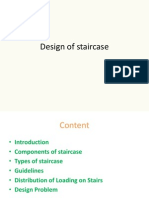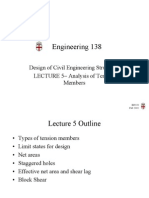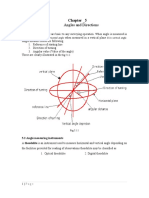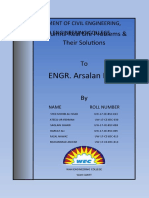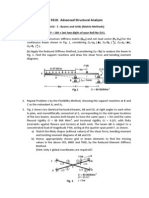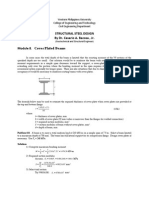Continuous Beam
Continuous Beam
Uploaded by
MadhavManikanthCopyright:
Available Formats
Continuous Beam
Continuous Beam
Uploaded by
MadhavManikanthCopyright
Available Formats
Share this document
Did you find this document useful?
Is this content inappropriate?
Copyright:
Available Formats
Continuous Beam
Continuous Beam
Uploaded by
MadhavManikanthCopyright:
Available Formats
!!!!!!!!!!!!!!!!!!
A B
C
D
3m 3m 3m
50kN
10kN/m
60kN-m
I = 60 50 40 x 10
6
mm
4
Continuous Beams - Flexibility Method
Qu.1
Sketch the BM diagram for the beam shown in Fig.1. Take E = 200kN/mm
2
.
Qu.2
Sketch the BM diagram for the beam shown in Fig.2. Take EI = constant.
Fig.1
25.7
23.5
16.9
60.0
BM diagram in kN-m units
!!!!!!!!!!!!!!!!!!!!!!!!!!!!!!!!
A B C D
2m 8m 4m
80kN
15kN/m
A B
C
D
20kN
= =
= =
A B C D
18.3
83.6
58.2 @ mid-span
40.0
BM diagram in kN-m units
Fig.2
!!!!!!!!!!!!!!!!!!!!!!!
A
B
C
D
8m 11m 8m
160kN
40kN/m
Continuous Beams - Flexibility Method
Qu.3
Sketch the BM diagram for the beam shown in Fig.3. Also calculate the
support reactions. Take EI const. [R
A
= -29.9 , R
B
= 236.8, R
C
= 381.1kN]
Qu.4
Sketch the BM diagram for the beam shown in Fig.4. Support B undergoes a
settlement of 15mm. Take E = 200kN/mm
2
and I = 1 x 10
-4
m
4
.
Fig.3
239.2
383.7
BM diagram in kN-m units
A
B C D
4m 8m 8m
A B
C
D
40kN
A
B
C
D
17.0
5.8
160.0
BM diagram in kN-m units
3m 5m
Fig.4
2m 6m
293.6
@ mid-span
84.4
80kN
179.8
End rotations of simply supported beams
Span = L Flexural rigidity = EI
"
#
UDL of intensity 1
# = " =
L
3
24EI
#
"
1
a
# =
L
2
(1 - $)(2 - $)$
6EI
" =
L
2
(1 - $
2
)$
6EI
$ =
a
L
1
1
2
1
1
2
f
11
f
12
f
21
f
22
L
3EI
f
11
=
L
6EI
f
12
=
L
6EI
f
21
=
L
3EI
f
22
=
Flexibility method applied to continuous beams
Example 1. Two-span continuous beam with the flexural rigidity EI = constant
Using statics
Res. vertically: R
A
+ R
B
+ R
C
= P + Q (1)
Taking mom. about C: R
A
x (L
AB
+ L
BC
) + R
B
x L
BC
= P x XC + Q x YC (2)
The three reactions are the unknowns but only two equations are available.
Therefore the problem is statically indeterminate. We must use compatibility
of displacements to generate an additional equation in order to complete the
solution.
One procedure for doing this is illustrated in the figures below:
R
A
R
B
L
AB
L
BC
A C B
P
Q
X Y
Step 1 Remove prop and calculate the deflection %
B
A C
B
A C B
P
Q
X Y
%
B
1
&
B
Step 2 Introduce unit force at B and calculate &
B
For compatibility R
B
= %
B
/ &
B
(3)
We use these three equations to solve for R
A
, R
B
and R
C
respectively.
The bending moment at B is M
B
= R
A
x L
AB
- P x XB (4)
R
C
A C
B
P
Q
M
B
Bending Moment Diagram
The major disadvantage of this method arises when EI varies from span to span.
The deflections cannot be calculated from standard tables which assume that
the flexural rigidity EI is constant.
The free-body diagram for the individual spans are given below:
A powerful method that does not suffer from this defect is now described. It
uses displacement compatibility and leads to the Three Moment Theorem. The
method breaks a continuous beam into a series of simply supported spans. The
slopes are therefore discontinuous over the supports. Rotations are then
introduced via the reactant moments to heal the cuts.
R
A
A
M
B
R
BA
P
C
B
R
C
R
BC
R
A
A
M
B
R
BA
P Q
R
B
=R
BA
+ R
BC
P
M
B
Reactant BM
Free BM
Final BM = Reactant BM + Free BM
Three Moment Theorem
Consider a continuous beam consisting of N spans.
A B I K J M
R
I
R
J
L
IJ
L
JK
I K J
R
K
"
J
tangent to curve
R
KL
R
JK
R
IJ
R
JI
R
J
=R
JI
+ R
Jk
K
J
I
M
J
M
I
M
K
#
JI
#
JK
I J K
Stage A : End rotations due to applied loads
K
J
I
M
J
M
I
M
K
$
'
Stage A : End rotations due to reactant moments
In order to restore continuity at joint J,
"
J
= #
JI
- $ = ' - #
JK
(a) (b) (i) (j)
1
f
11
1
1
2
1
2
f
12
f
21
f
22
Flexibility Coefficients: End rotations due to unit couples
Making use of the flexibility coefts shown above we may write the
compatibility condition as follows:
#
JI
- M
I
f
i
12
- M
J
f
i
22
= M
J
f
j
11
- M
K
f
j
21
- #
JK
or
M
I
f
i
12
+ M
J (
f
j
11
+ f
i
22
) + M
K
f
j
21
= #
JI
+ #
JK
Note f
i
12
= (L/6EI)
IJ
, f
i
22
= (L/3EI)
IJ
, f
j
11
= (L/3EI)
JK
, f
j
21
= (L/6EI)
JK
This is the so-called Three Moment Theorem (due to Clapeyron).
Settlement of supports
The theorem can be easily extended to deal with settlement of supports. Let %
J
be the settlement of support J. The rotations on each side of support J due to
the differential settlement are (%
J
- %
I
)/L
IJ
and (%
J
- %
K
)/L
JK
respectively.
We get
M
I
f
i
12
+ M
J (
f
j
11
+ f
i
22
) + M
K
f
j
21
= (#
JI
- (%
J
- %
I
)/L
IJ
) +
(#
JK
- (%
J
- %
K
)/L
JK
)
Fixed end (zero rotation)
A fixed end, A in the figure above, does not rotate. The rotation #
AB
must
therefore be balanced by the reactant rotations. We have
M
A
f
a
11
+ M
B
f
a
21
= #
AB
- (%
A
- %
B
)/L
AB
R
BC
R
AB
R
BA
B
A
M
B
M
A
!!!!!!!!!!!!!!!!!!!!!!!!!!!!!!!!!!!!!
A
B
C
3m 3m
10kN/m
Worked examples
Example 1.
Calculate the reactions at the supports of the beam shown in Fig.1. The
flexural rigidity EI is the same for both spans.
Fig.1
!!!!!!!!!!!!!!!!!!!!!!!!!!!!!!!!!!!!!
A
B
C
10kN/m
Step 1
Remove prop
%
B
&
B
1
Step 2
Apply unit
load
%
B
= 5 x 10 x 6
4
/(384EI) = 168.75/EI
&
B
= 1 x 6
3
/(48EI) = 4.5/EI
Let R
B
denote the reaction at the support B in Fig. 1 then
R
B
&
B
= %
B
which yields
R
B
= 37.5kN
Resolving vertically we get for the beam in Fig. 1,
R
A
+ R
B
+ R
C
= 60
Also R
A
= R
C
by symmetry
Therefore R
A
= 11.25kN
A
B
L
Worked examples
Example 2.
Calculate the rotations at the supports of the beam shown in Fig.2. The flexural
rigidity is EI.
Fig.2
A
B
BM diagram
Apply EI d
2
y/dx
2
= -M
= x/L
Integrating EI dy/dx = x
2
/(2L) + C , C is a constant
[1]
Integrating again EI y = x
3
/(6L) + Cx + D
[2]
Applying b.cs :
At x = 0 , y = 0 D = 0 from Eq.[2]
At x = L, y = 0 C = -L/6
Substituting in Eq.{1] EI#
A
= C = -L/6 or #
A
= -L/(6EI)
EI#
B
= L/2 + C or #
B
= L/(3EI)
Note: The difference in signs of the rotations is due to the direction of the
rotation. A positive sign denotes an clockwise rotation whilst the negative
sign denotes an anti-clockwise rotation.
1
1
x
x/L
Deflection
diagram
#
A
#
B
Worked examples
Example 3.
Draw the BM diagram for the beam shown in Fig. 3 below. The flexural rigidity EI
is the same for both spans.
!!!!!!!!!!!!!!!!!
A
B
C
3m 2m
5kN/m
Fig.3
2m
200kN
We note that M
A
= 0 and M
C
= 0 , simple supports. Applying the three-moment
theorem at B we get
2 3
+ M
B
= #
BA
+ #
BC
3EI 3EI
= 815/(9EI)
(
)
= 54.33kN-m
54.3
133.3
2.5
18.1
115.2
27.2
24.7
Reactant BM
(kN-m)
Free BM
(kN-m)
Final BM
(kN-m)
Worked examples
Example 4.
Calculate the bending moments at the supports of the beam in Fig.4. The flexural
rigidity EI is the same for all spans.
!!!!!!!!!!!!!!!!!
A
B
C
3m 2m
5kN/m
Fig.4
2m
200kN
We note that M
A
= 0 and M
D
= 0 , simple supports. Applying the three-moment we
get:
Joint B Taking EI = 1, [2/3 + 3/3] M
B
+ 3/6 M
C
= 5/3 + 800/9
10 (
)
+ 3 M
C
= 543.3 [1]
Joint C 3/6 M
B
+ [3/3 + 2/3] M
C
= 1000/9 + 100
3 M
B
+ 10 M
C
= 1266.7 [2]
Solving Eqs.[1] and [2] we get
M
B
= 18.0kN-m M
C
= 121.3kN-m
D
2m
400kN
= =
Worked examples
Example 5.
Rework the problem of example 3 taking the support A as being fixed.
!!!!!!!!!!!!!!!!!
A
B
C
3m 2m
5kN/m
Fig.3
2m
200kN
We note that M
C
= 0 , simple support. Applying the three-moment theorem at B we
get:
Joint A Taking EI = 1, 2/3 M
A
+ 2/6 M
B
= 5/3
4 M
A
+ 2 M
B
= 10 [1]
Joint B 2/6 M
A
+ [2/3 + 3/3] M
B
= 815/9
4 M
A
+ 20 M
B
= 1086.7 [2]
Eqs.[1] and [2] M
A
= -27.4kN-m M
B
= 59.8kN-m
59.8
133.3
2.5
19.9
113.4
27.4
Reactant BM
(kN-m)
Free BM
(kN-m)
Final BM
(kN-m)
27.4
You might also like
- BFC 43201 Structural Key Plan / Structural Drawing: by Shahrul Niza Bin Mokhatar Shahruln@uthm - Edu.myDocument34 pagesBFC 43201 Structural Key Plan / Structural Drawing: by Shahrul Niza Bin Mokhatar Shahruln@uthm - Edu.mySusi MulyaniNo ratings yet
- Estimating 1 IgnouDocument248 pagesEstimating 1 IgnouVVRAO900% (1)
- Design and Drawing of RC Structures: Dr. G.S.SureshDocument47 pagesDesign and Drawing of RC Structures: Dr. G.S.SureshAniket Waghmare100% (1)
- Tutorial 3 DeflectionDocument4 pagesTutorial 3 DeflectionAbelBayartNo ratings yet
- Inclined Columns Design - Loads and Bending Moment in Inclined ColumnDocument5 pagesInclined Columns Design - Loads and Bending Moment in Inclined ColumnJustin Musopole100% (2)
- Continuous - Beams Design ExamplesDocument4 pagesContinuous - Beams Design ExamplesWONG TSNo ratings yet
- 7.continuous BeamsDocument35 pages7.continuous BeamsTareck BOU JAOUDENo ratings yet
- Slab Design FlowDocument4 pagesSlab Design FlowLerie Lou R. PenarroyoNo ratings yet
- RC DESIGN-ColumnsDocument29 pagesRC DESIGN-Columnsdilnessa azanawNo ratings yet
- Design of Tension MembersDocument10 pagesDesign of Tension MembersSandgrouse RajNo ratings yet
- Strapped Footing DesignDocument10 pagesStrapped Footing DesignRyanRuceMelville0% (1)
- Module3 Design of Tension MembersDocument33 pagesModule3 Design of Tension MembersPrem KumarNo ratings yet
- RCC51 Column Load Take-Down & DesignDocument8 pagesRCC51 Column Load Take-Down & Designعصام السامرائي100% (1)
- Ce 208Document58 pagesCe 208julesNo ratings yet
- Design of Tension MembersDocument11 pagesDesign of Tension MembersWilfharry billyNo ratings yet
- Arrangement of Reinforcement in Typical Concrete MembersDocument13 pagesArrangement of Reinforcement in Typical Concrete Membersa_j_sanyal259No ratings yet
- Lecture 6 - Design of RC SlabsDocument21 pagesLecture 6 - Design of RC SlabsTuan Jalai100% (1)
- MiscellaneousDocument49 pagesMiscellaneousjrsvalenzuelaNo ratings yet
- Analysis and Design of Flat Slabs Using Various CodesDocument5 pagesAnalysis and Design of Flat Slabs Using Various CodesInternational Journal of Research in Engineering and TechnologyNo ratings yet
- Ocw RCD1 5eDocument19 pagesOcw RCD1 5eKousalya MkNo ratings yet
- Design of StaircaseDocument28 pagesDesign of Staircasesirfmein82% (11)
- Ce2306 Design of RC Elements V Semester eDocument239 pagesCe2306 Design of RC Elements V Semester eAnonymous faybPdFy50% (2)
- RCII Column Design Solved Examples: Example 2.1. (Classification of Columns)Document18 pagesRCII Column Design Solved Examples: Example 2.1. (Classification of Columns)Dechas MohammedNo ratings yet
- Ribbed Slab DesignDocument33 pagesRibbed Slab DesignBahru k.No ratings yet
- Analysis of Tension MembersDocument19 pagesAnalysis of Tension MembersCivilEngClub100% (1)
- Angles and Directions: Chapter - 5Document21 pagesAngles and Directions: Chapter - 5yared molaNo ratings yet
- Chapter 3b - Analysis of Tension MembersDocument56 pagesChapter 3b - Analysis of Tension MembersRami DemachkiNo ratings yet
- Beam Design SpreadsheetDocument5 pagesBeam Design Spreadsheetewanz89100% (1)
- Vertical Loads On Building Frames: Assumptions For The Analysis of Girders Using Approximate AnalysisDocument10 pagesVertical Loads On Building Frames: Assumptions For The Analysis of Girders Using Approximate AnalysisNeven Ahmed HassanNo ratings yet
- Chapter 3 Tension DesignDocument6 pagesChapter 3 Tension Designaisha nakatoNo ratings yet
- II Structural Analysis Unit 4 1Document28 pagesII Structural Analysis Unit 4 1J.R. EnginnerNo ratings yet
- Design of RCC ColumnsDocument14 pagesDesign of RCC Columnsprashmce100% (1)
- 4-Flexural Members or Beams PDFDocument39 pages4-Flexural Members or Beams PDFKellen Brumbaugh100% (1)
- Rectangular Reinforced Concrete BeamDocument60 pagesRectangular Reinforced Concrete BeamMedianna Novita100% (1)
- Structural Analysis 7 Edition in SI UnitsDocument47 pagesStructural Analysis 7 Edition in SI UnitsChime MornNo ratings yet
- Rreinforced Concrete-Beam DesignDocument38 pagesRreinforced Concrete-Beam DesignMohamed AbdNo ratings yet
- Design of RC FootingDocument17 pagesDesign of RC FootingSwopnilOjhaNo ratings yet
- Preliminary Design: Area of Steel Required Area of Steel ProvidedDocument10 pagesPreliminary Design: Area of Steel Required Area of Steel ProvidedArchana Poudel100% (1)
- Column Design - ExampleDocument9 pagesColumn Design - Examplekassahun kebede100% (1)
- Columns-Real Life Problems & Their SolutionsDocument33 pagesColumns-Real Life Problems & Their SolutionsAteeq RehmanNo ratings yet
- Flat SlabDocument38 pagesFlat SlabRicky Gunawan100% (1)
- Limit State Design PDFDocument21 pagesLimit State Design PDFKrishna DhageNo ratings yet
- Cont Beam DesignDocument76 pagesCont Beam Designsiti HawaNo ratings yet
- Calculating Bulk Volumes Using Simpson Rule PDFDocument10 pagesCalculating Bulk Volumes Using Simpson Rule PDFEng Ravi Kant SharmaNo ratings yet
- Beams Sb1, Group 1 and 6Document29 pagesBeams Sb1, Group 1 and 6Wilbert Carlo RachoNo ratings yet
- Design Examples of RC Beam PDFDocument36 pagesDesign Examples of RC Beam PDFWendimu TolessaNo ratings yet
- Safe Load Carrying Capacity For RCC Columns (Load in KN) FCK 20N/MM2 Fy 415N/MM2 Size of Columns (CM X CM)Document9 pagesSafe Load Carrying Capacity For RCC Columns (Load in KN) FCK 20N/MM2 Fy 415N/MM2 Size of Columns (CM X CM)rajanciviltnebNo ratings yet
- Timber Design - ConnectionsDocument10 pagesTimber Design - ConnectionsEmmanuel Lazo100% (1)
- 5.3 Slab 5.3.1 Slab: Office Area: Ref. Calculation OutputDocument27 pages5.3 Slab 5.3.1 Slab: Office Area: Ref. Calculation OutputNH SyzlnNo ratings yet
- Problem 813 - Continuous Beam by Three-Moment Equation - Strength of Materials ReviewDocument4 pagesProblem 813 - Continuous Beam by Three-Moment Equation - Strength of Materials ReviewJhundel Factor PajarillagaNo ratings yet
- Chapter 2 Tension MembersDocument8 pagesChapter 2 Tension MembersGamtesa EjetaNo ratings yet
- 2.3 Section Properties of Built-Up Steel Sections PDFDocument5 pages2.3 Section Properties of Built-Up Steel Sections PDFkhx2No ratings yet
- Welded Bracket Connection 4Document8 pagesWelded Bracket Connection 4Sandy TrumpNo ratings yet
- 3 Moments EquationDocument15 pages3 Moments EquationJuan Carlos Urueña CruzNo ratings yet
- STR AnalysisDocument136 pagesSTR AnalysisWeha Yu100% (1)
- CE4 Module 3Document9 pagesCE4 Module 3bacalczynahmaeNo ratings yet
- Interim PHD ReportDocument54 pagesInterim PHD Reportjblaze747No ratings yet
- m3l16 Lesson 16 The Slope-Deflection Method: Frames Without SideswayDocument24 pagesm3l16 Lesson 16 The Slope-Deflection Method: Frames Without SideswayVitor Vale100% (1)
- Tutorial 2 SolutionsDocument6 pagesTutorial 2 Solutionsutsav_koshtiNo ratings yet
- Unit4-Kani's Method PDFDocument34 pagesUnit4-Kani's Method PDFnvnrevNo ratings yet
- Assignment 5Document1 pageAssignment 5Pinakin GoreNo ratings yet
- New Price List Ver 1-21-22 MRP OdDocument25 pagesNew Price List Ver 1-21-22 MRP OdMadhavManikanthNo ratings yet
- Gurvashtakam: Please Help To Maintain Respect For Volunteer SpiritDocument5 pagesGurvashtakam: Please Help To Maintain Respect For Volunteer SpiritMadhavManikanthNo ratings yet
- 5 6131664061034660367Document120 pages5 6131664061034660367MadhavManikanthNo ratings yet
- S.no Shutter Description and Colour Width Height: Plot No 15 Gokulam HeightsDocument4 pagesS.no Shutter Description and Colour Width Height: Plot No 15 Gokulam HeightsMadhavManikanthNo ratings yet
- Borrow Pits Should Preferably Be Located inDocument30 pagesBorrow Pits Should Preferably Be Located inMadhavManikanthNo ratings yet
- Tharpanam ProcedureDocument26 pagesTharpanam ProcedureSriram Krishnamoorthy100% (2)
- Dakshina Murthy Stotram Telugu LargeDocument4 pagesDakshina Murthy Stotram Telugu LargeMadhavManikanthNo ratings yet
- Resume FormatDocument3 pagesResume FormatMadhavManikanthNo ratings yet
- Reinforced Concrete Design - Palestine Ii - ACI 318M-08Document282 pagesReinforced Concrete Design - Palestine Ii - ACI 318M-08EVER GUZMAN BALCASNo ratings yet
- Unit 2 Variable Stresses, Design of Shafts, Keys and CouplingsDocument134 pagesUnit 2 Variable Stresses, Design of Shafts, Keys and CouplingsDravid PrabaNo ratings yet
- SOM NotesDocument88 pagesSOM NotesThiru Moorthy100% (1)
- Strength of Material CHAPTERDocument21 pagesStrength of Material CHAPTERHiwot DemisseNo ratings yet
- Chapter-1: ObjectiveDocument55 pagesChapter-1: ObjectiveraisNo ratings yet
- Progressive Collapse Analysis of A Multistorey RCC Building Using Pushover AnalysisDocument4 pagesProgressive Collapse Analysis of A Multistorey RCC Building Using Pushover AnalysisAnonymous GlDaR6gBNo ratings yet
- Three Moment Equation For BeamsDocument12 pagesThree Moment Equation For BeamsRico EstevaNo ratings yet
- نوتة حسابية لمبني مدرسةDocument22 pagesنوتة حسابية لمبني مدرسةAli AdelNo ratings yet
- SSC JE Civil (2016) SET 4 Watermark - PDF 49Document11 pagesSSC JE Civil (2016) SET 4 Watermark - PDF 49Safikul HossainNo ratings yet
- Continous Beams by TheoremDocument28 pagesContinous Beams by Theoremchaitu kNo ratings yet
- Code Commentary: Factored Torsion Factored TorsionDocument5 pagesCode Commentary: Factored Torsion Factored TorsionMin KhantNo ratings yet
- Special Assignment 1 327 18 Theory of StructuresDocument9 pagesSpecial Assignment 1 327 18 Theory of StructuresDonna MoralesNo ratings yet
- Bored Tunnels in Soft SoilsDocument7 pagesBored Tunnels in Soft SoilsDEBASISNo ratings yet
- Solid Mechanics Question BankDocument10 pagesSolid Mechanics Question BankMugilan VinsNo ratings yet
- Answer:: A. B. C. D. EDocument51 pagesAnswer:: A. B. C. D. EselvakumarNo ratings yet
- Design Report of Steel StructureDocument61 pagesDesign Report of Steel StructureMd Humayun KabirNo ratings yet
- Base Isolation OptimizationDocument22 pagesBase Isolation OptimizationAzhar PLNo ratings yet
- (I) (Id Hours: Jio (C)Document6 pages(I) (Id Hours: Jio (C)Arjun OrcsNo ratings yet
- Chapter 3 - Complete Beam DesignDocument18 pagesChapter 3 - Complete Beam DesignAnonymous tjIk84No ratings yet
- Section 4 - Determinate Beam and Frame Analysis Annotated Oct20Document35 pagesSection 4 - Determinate Beam and Frame Analysis Annotated Oct20Colin MacDougallNo ratings yet
- Structural Steel Design by Dr. Cesario A. Bacosa, Jr. - Cover Plated BeamsDocument2 pagesStructural Steel Design by Dr. Cesario A. Bacosa, Jr. - Cover Plated Beamsdash1991No ratings yet
- Chapter One Shaft DesignDocument71 pagesChapter One Shaft DesignhaymanotNo ratings yet
- Refresher - Structural Design and Construction: Inhinyero Review CenterDocument4 pagesRefresher - Structural Design and Construction: Inhinyero Review Centermichael SonuganNo ratings yet
- Pipingflexibilityanalysis PDFDocument762 pagesPipingflexibilityanalysis PDFhirenkumar patel100% (2)
- Assignment 1Document2 pagesAssignment 1daffy duckNo ratings yet
- Lecture Notes Lectures 6 10Document58 pagesLecture Notes Lectures 6 10Penelope MalilweNo ratings yet
- Lec (3) Part 2 Combined FootingDocument44 pagesLec (3) Part 2 Combined FootingDemse ZelelewNo ratings yet




















